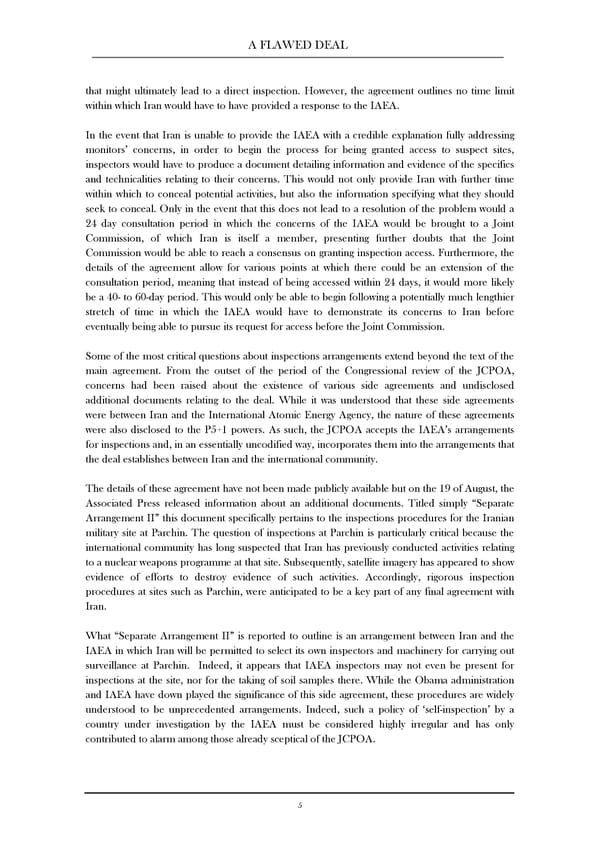! A FLAWED DEAL that might ultimately lead to a direct inspection. However, the agreement outlines no time limit within which Iran would have to have provided a response to the IAEA. In the event that Iran is unable to provide the IAEA with a credible explanation fully addressing monitors’ concerns, in order to begin the process for being granted access to suspect sites, inspectors would have to produce a document detailing information and evidence of the specifics and technicalities relating to their concerns. This would not only provide Iran with further time within which to conceal potential activities, but also the information specifying what they should seek to conceal. Only in the event that this does not lead to a resolution of the problem would a 24 day consultation period in which the concerns of the IAEA would be brought to a Joint Commission, of which Iran is itself a member, presenting further doubts that the Joint Commission would be able to reach a consensus on granting inspection access. Furthermore, the details of the agreement allow for various points at which there could be an extension of the consultation period, meaning that instead of being accessed within 24 days, it would more likely be a 40- to 60-day period. This would only be able to begin following a potentially much lengthier stretch of time in which the IAEA would have to demonstrate its concerns to Iran before eventually being able to pursue its request for access before the Joint Commission. Some of the most critical questions about inspections arrangements extend beyond the text of the main agreement. From the outset of the period of the Congressional review of the JCPOA, concerns had been raised about the existence of various side agreements and undisclosed additional documents relating to the deal. While it was understood that these side agreements were between Iran and the International Atomic Energy Agency, the nature of these agreements were also disclosed to the P5+1 powers. As such, the JCPOA accepts the IAEA’s arrangements for inspections and, in an essentially uncodified way, incorporates them into the arrangements that the deal establishes between Iran and the international community. The details of these agreement have not been made publicly available but on the 19 of August, the Associated Press released information about an additional documents. Titled simply “Separate Arrangement II” this document specifically pertains to the inspections procedures for the Iranian military site at Parchin. The question of inspections at Parchin is particularly critical because the international community has long suspected that Iran has previously conducted activities relating to a nuclear weapons programme at that site. Subsequently, satellite imagery has appeared to show evidence of efforts to destroy evidence of such activities. Accordingly, rigorous inspection procedures at sites such as Parchin, were anticipated to be a key part of any final agreement with Iran. What “Separate Arrangement II” is reported to outline is an arrangement between Iran and the IAEA in which Iran will be permitted to select its own inspectors and machinery for carrying out surveillance at Parchin. Indeed, it appears that IAEA inspectors may not even be present for inspections at the site, nor for the taking of soil samples there. While the Obama administration and IAEA have down played the significance of this side agreement, these procedures are widely understood to be unprecedented arrangements. Indeed, such a policy of ‘self-inspection’ by a country under investigation by the IAEA must be considered highly irregular and has only contributed to alarm among those already sceptical of the JCPOA. 5 ! !
 A Flawed Deal Page 7 Page 9
A Flawed Deal Page 7 Page 9